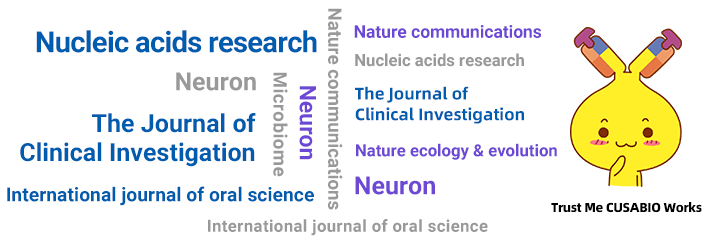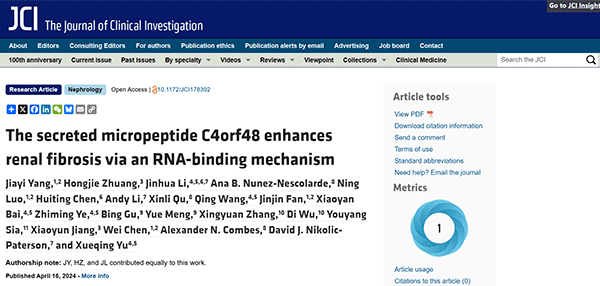Thank you for your continued support of CUSABIO! In August 2024, articles related to CUSABIO products were published in excess of 240, with a cumulative impact factor exceeding 1200. The total number of articles has reached 23,400. Thank you for choosing CUSABIO research products during your scientific research journey. Thank you again for your trust and support. We will continue to work hard to provide you with better products and services. Now let's share our wonderful research results.
CUSABIO Monthly Citations Review
01 Programmable RNA 5-methylcytosine (m5C) modification of cellular RNAs by dCasRx conjugated methyltransferase and demethylase
Impact Factor: 16.6
Journal Name: Nucleic acids research
CUSABIO Citation Product:
TRAF7 Antibody; CSB-PA780056
Research Highlights:
This article introduces a CRISPR-Cas13d-based tool called the reengineered m5C modification system (RCMS) for targeted methylation and demethylation of m5C at specific RNA transcripts. The study include:
1. Development of RCMS editors capable of precisely manipulating methylation events at specific m5C sites.
2. Confirmation of RCMS editors' effectiveness in modulating m5C levels within tRNAs and their impact on transcript abundance and cell proliferation.
3. Provision of a novel tool for epitranscriptome engineering, facilitating the elucidation of the effects of specific m5C modifications on biological phenotypes.
02 The secreted micropeptide C4orf48 enhances renal fibrosis via an RNA-binding mechanism
Impact Factor: 15.9
Journal Name: The Journal of Clinical Investigation
CUSABIO Citation Product:
Human Neuropeptide-like protein C4orf48(C4orf48) ELISA kit; CSB-EL003989HU
Research Highlights:
The article investigates how a secreted micropeptide named C4orf48 enhances renal fibrosis through an RNA-binding mechanism. It was found that C4orf48 is upregulated in a diabetic nephropathy mouse model and in renal tubular epithelial cells in human and experimental chronic kidney disease (CKD). Serum C4orf48 levels correlate with kidney function loss, CKD stage, and the degree of active interstitial fibrosis in humans with CKD. Overexpression of C4orf48 in mice accelerates renal fibrosis, while the deletion or knockdown of the C4orf48 gene significantly reduces renal fibrosis in CKD models. Moreover, C4orf48 acts as an RNA-binding peptide to promote the production of extracellular matrix.
03 Multiomics profiling reveals VDR as a central regulator of mesenchymal stem cell senescence with a known association with osteoporosis after high-fat diet exposure
Impact Factor: 14.9
Journal Name: International journal of oral science
CUSABIO Citation Product:
Mouse Interleukin 6,IL-6 ELISA KIT; CSB-E04639m
Research Highlights:
This article explores how a high-fat diet (HFD) contributes to the development of osteoporosis by affecting the senescence of bone marrow mesenchymal stem cells (BMSCs) through multi-omics analysis. The study found that HFD-induced BMSCs senescence is associated with the weakening of vitamin D receptor (VDR) signaling. By administering a VDR activator, HFD-induced BMSCs senescence can be alleviated, and osteogenesis, bone mass, and other bone parameters can be improved. The study include: 1) Revealing a new mechanism by which HFD induces BMSCs senescence through the VDR-superoxide dismutase 2 (SOD2)- reactive oxygen species (ROS) axis; 2) Providing a potential strategy for treating HFD-induced osteoporosis by modulating VDR signaling.
04 Therapeutic potential of human microglia transplantation in a chimeric model of CSF1R-related leukoencephalopathy
Impact Factor: 14.7
Journal Name: Neuron
CUSABIO Citation Product:
Mouse myelin basic protein,MBP ELISA Kit; CSB-E08285m
Research Highlights:
This article explores the therapeutic potential of transplanting human induced pluripotent stem cell (iPSC)-derived microglia in a rare genetic neurological disorder known as CSF1R-related leukoencephalopathy (ALSP). The researchers generated a novel mouse model that mimics various pathological features in the brains of ALSP patients by deleting the FIRE enhancer within the CSF1R gene. The study found that transplanting healthy human iPSC-derived microglial progenitors into these mice could prevent the development of ALSP-related neuropathologies. Moreover, transplantation of CRISPR-corrected microglia derived from ALSP patients' iPSCs could reverse pre-existing neuropathologies in the mouse model. These findings suggest that iPSC microglia transplantation may offer a new therapeutic strategy for ALSP and other primary microgliopathies.
05 Apelin modulates inflammation and leukocyte recruitment in experimental autoimmune encephalomyelitis
Impact Factor: 14.7
Journal Name: Nature communications
CUSABIO Citation Product:
Human apelin 13,AP13 ELISA Kit; CSB-E13072h
Research Highlights:
The research highlights the significant alleviation of symptoms in experimental autoimmune encephalomyelitis (EAE) by apelin peptide, which is achieved by reducing immune cell infiltration into the brain, delaying disease onset, and decreasing disease severity. The study also reveals that apelin affects the trafficking of leukocytes by modulating the expression of cell adhesion molecules on lung endothelial cells and induces internalization and desensitization of its receptor in these cells. These findings underscore the role of apelin in regulating immune cell migration in the lung and suggest potential targets for developing new therapies for multiple sclerosis (MS).
06 PKM2 aggregation drives metabolism reprograming during aging process
Impact Factor: 14.7
Journal Name: Nature communications
CUSABIO Citation Product:
Mouse Interleukin 1α,IL-1α ELISA kit; CSB-E04621m
Mouse Tumor necrosis factor α,TNF-α ELISA KIT; CSB-E04741m
Research Highlights:
This article investigates the role of PKM2 protein aggregation in the aging process and discovers two small molecule compounds, K35 and K27, which can dissolve PKM2 aggregates, alleviate cellular senescence, and extend the lifespan of aged mice. The study include:
1. Unveiling the significant role of PKM2 aggregates in cellular senescence and aging phenotypes.
2. Identifying compounds K35 and K27 capable of dissolving PKM2 aggregates through a two-step small molecule library screening.
3. Treatment with K35 and K27 not only alleviates aging-associated characteristics but also extends the lifespan of naturally aged and prematurely aged mice.
07 Small molecule in situ resin capture provides a compound first approach to natural product discovery
Impact Factor: 14.7
Journal Name: Nature communications
CUSABIO Citation Product:
Recombinant Human Transmembrane protease serine 2 (TMPRSS2), partial (Active); CSB-YP023924HU
Research Highlights:
This article introduces a new method called "Small Molecule In situ Resin Capture" (SMIRC), which is a culture-independent technique for directly capturing natural products from their producing environments. The researchers used SMIRC to capture a variety of compounds from marine environments, including two new compounds with novel carbon skeletons characterized by NMR. These findings reveal metabolomic signatures consistent with the diversity of biological communities and provide new avenues for drug discovery and the detection of chemically mediated biotic interactions.
08 Single-cell analysis reveals a subpopulation of adipose progenitor cells that impairs glucose homeostasis
Impact Factor: 14.7
Journal Name: Nature communications
CUSABIO Citation Product:
Human pigment epithelium-derived factor,PEDF ELISA Kit; CSB-E08818h
Research Highlights:
This article uncovers the heterogeneity of adipose progenitor cells (APCs) in type 2 diabetes (T2D) through single-cell analysis, particularly the CD9+CD55low subset, which is increased in T2D patients and promotes disease progression by forming a detrimental microenvironment. The study include:
1. Identification of four subsets of APCs in human visceral adipose tissue, with altered composition and functionality in T2D patients.
2. Increased frequency of CD9+CD55low APCs in T2D, positively correlating with glycemic control indicators.
3. Revelation of how CD9+CD55low APCs promote lipolysis and cause insulin resistance and glucose intolerance by secreting various bioactive proteins.
4. Improvement of obesity-related metabolic disorders through genetic or pharmacological depletion of these pathogenic APCs.
09 Hyperbaric oxygen enhances tumor penetration and accumulation of engineered bacteria for synergistic photothermal immunotherapy
Impact Factor: 14.7
Journal Name: Nature communications
CUSABIO Citation Product:
Mouse High mobility group protein B1,HMGB-1 ELISA Kit; CSB-E08225m
Research Highlights:
This article investigates how hyperbaric oxygen (HBO) therapy enhances the penetration and accumulation of engineered bacteria within tumors for synergistic photothermal immunotherapy. The study found that HBO treatment effectively reduces the extracellular matrix within tumors, thereby promoting the accumulation of engineered bacteria. The researchers used Escherichia coli Nissle 1917 (EcN) as a model bacterium, modifying its surface for photothermal therapy and inducing immunogenic cell death (ICD). HBO treatment significantly increased the accumulation of EcN within tumors and facilitated the infiltration of immune cells, achieving desirable tumor eradication through photothermal therapy and ICD-induced immunotherapy. The study provides a simple and non-invasive strategy to enhance the delivery efficiency of natural/engineered bacteria within tumors and may promote the clinical translation of bacteria-mediated synergistic cancer therapy.
10 Obesity-associated microbiomes instigate visceral adipose tissue inflammation by recruitment of distinct neutrophils
Impact Factor: 14.7
Journal Name: Nature communications
CUSABIO Citation Product:
Human Lipopolysaccharides,LPS ELISA Kit; CSB-E09945h
Human zonulin ELISA kit; CSB-EQ027649HU
Research Highlights:
This article investigates how high-fat diet (HFD) exacerbates obesity-related inflammation and metabolic disorders by affecting the senescence of bone marrow mesenchymal stem cells (BMSCs). The study found that the number of neutrophils in the visceral adipose tissue of obese individuals is increased and associated with specific bacterial communities. By examining the effects of microbiome depletion and fecal microbiota transplantation in a high-fat diet mouse model, scientists discovered that the modulation of neutrophil accumulation could be regulated, and the activation of the vitamin D receptor (VDR) could reduce BMSCs senescence and improve osteogenesis and bone mass. The study include: 1) Revealing the association between HFD-induced BMSCs senescence and specific gut bacteria; 2) Identifying the key role of VDR signaling in regulating BMSCs senescence and bone metabolism; 3) Providing a new strategy for treating obesity-related inflammatory complications by modulating the VDR-superoxide dismutase 2 (SOD2)-reactive oxygen species (ROS) axis.
23000+ Published Papers!
CUSABIO team. CUSABIO Monthly Citations Review: In August, 240 High-Impact Citations, 23,400 Total Articles!. https://www.cusabio.com/c-21190.html














